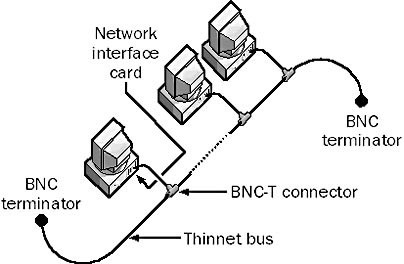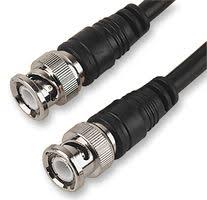Definition of 10Base2 in The Network Encyclopedia.
What is 10Base2?
10Base2 is a type of standard for implementing Ethernet networks. 10Base2 is sometimes referred to as thinnet (or “thin coax”) because it uses thin coaxial cabling for connecting stations to form a network. 10Base2 supports a maximum bandwidth of 10 Mbps, but in actual networks, the presence of collisions reduces this to more like 4 to 6 Mbps.
10Base2 is based on the 802.3 specifications of Project 802 developed by the Institute of Electrical and Electronic Engineers (IEEE).

How 10Base-2 work?
10Base2 networks are wired together in a bus topology, in which individual stations (computers) are connected directly to one long cable. The maximum length of any particular segment of a 10Base2 network is 185 meters. If distances longer than this are required, two or more segments must be connected using repeaters. Altogether, there can be a total of five segments connected using four repeaters, as long as only three of the segments have stations attached to them. This is referred to as the 5-4-3 rule.
A 10Base2 segment should have no more than 30 stations wired to it. The minimum distance between these stations must be 0.5 meters. Stations are attached to the cable using BNC connectors, and the ends of the thinnet cabling have BNC cable connectors soldered or crimped to them.
The designation 10Base2 comes from the speed of the network (10 Mbps), the signal transmission method (baseband transmission), and the maximum segment length (185 meters, rounded off to 200 with the zeros removed).

NOTE:
10Base2 networks are not implemented much anymore for two reasons. First, because their speed is limited to 10 Mbps, the networks perform poorly in today’s bandwidth-hungry, Internet-connected world. Second, 10Base2 networks have a single point of failure – the long, linear bus cable used to connect the stations. A single break or loose connection brings down the entire network, and every cable segment and station connection must be checked to determine the problem. If you are wiring an office for a small LAN with low bandwidth requirements, use 10BaseT instead. For moderate to high bandwidth requirements, try using Fast Ethernet instead.
Use Terminators
The two ends of a 10Base2 bus must be properly terminated. If they are not, signals will bounce and network communications will be impossible.
See also:
You certainly are going to be interested in:
- Media converter from 10BASE2 / 10BASE-T: see the latest price
- RG58 Thinnet 10Base2 Coax Cable – BC – White – 15 Feet: see latest price
- MPD Digital Bulk Coax Cable with Connectors: Coax cable 10BASE2-BNC-male (from Amazon)